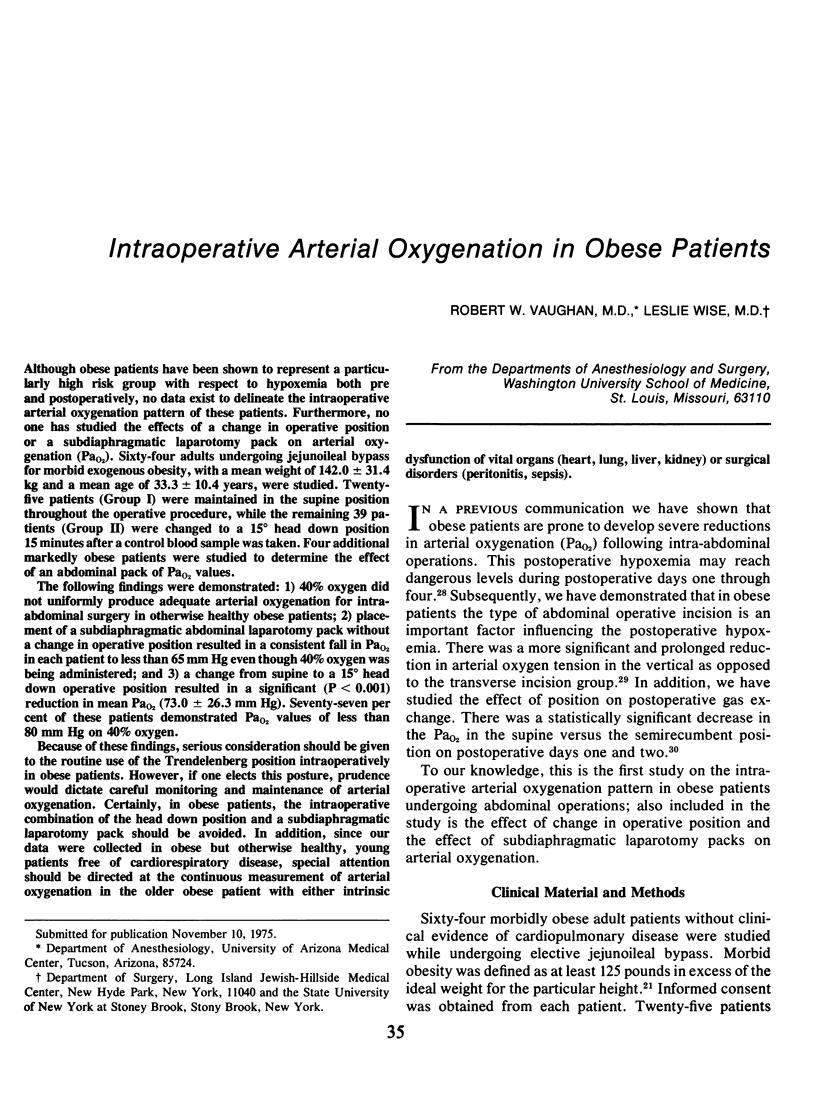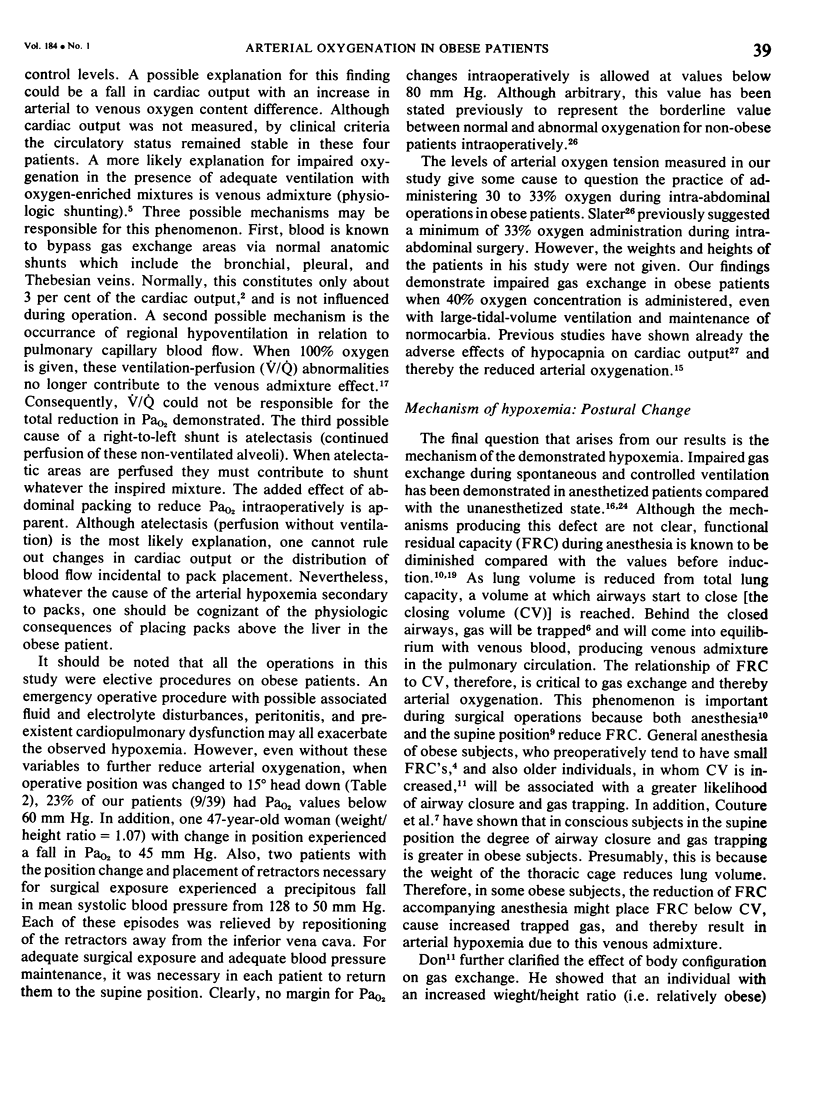Abstract
Although obese patients have been shown to represent a particularly high risk group with respect to hypoxemia both pre and postoperatively, no data exist to delineate the intraoperative arterial oxygenation pattern of these patients. Furthermore, no one has studied the effects of a change in operative position or a subdiaphragmatic laparotomy pack on arterial oxygenation (PaO2). Sixty-four adults undergoing jejunoileal bypass for morbid exogenous obesity, with a mean weight of 142.0 +/- 31.4 kg and a mean age of 33.3 +/- 10.4 years, were studied. Twenty-five patients (Group I) were maintained in the supine position throughout the operative procedure, while the remaining 39 patients (Group II) were changed to a 15 degrees head down position 15 minutes after a control blood sample was taken. Four additional markedly obese patients were studied to determine the effect of an abdominal pack of PaO2 values. The following findings were demonstrated: 1) 40% oxygen did not uniformly produce adequate arterial oxygenation for intra-abdominal surgery in otherwise healthy obese patients; 2) placement of a subdiaphragmatic abdominal laparotomy pack without a change in operative position resulted in a consistent fall in PaO2 in each patient to less than 65 mm Hg even though 40% oxygen was being administered; and 3) a change from supine to a 15 degrees head down operative position resulted in a significant (P less than 0.001) reduction in mean PaO2 (73.0 +/- 26.3 mm Hg). Seventy-seven per cent of these patients demonstrated PaO2 values of less than 80 mm Hg on 40% oxygen. Because of these findings, serious consideration should be given to the routine use of the Trendelenberg position intraoperatively in obese patients. However, if one elects this posture, prudence would dictate careful monitoring and maintenance of arterial oxygenation. Certainly, in obese patients, the intraoperative combination of the head down position and a subdiaphragmatic laparotomy pack should be avoided. In addition, since our data were collected in obese but otherwise healthy, young patients free of cardiorespiratory disease, special attention should be directed at the continuous measurement of arterial oxygenation in the older obese patient with either intrinsic dysfunction of vital organs (heart, lung, liver, kidney) or surgical disorders (peritonitis, sepsis).
Full text
PDF







Selected References
These references are in PubMed. This may not be the complete list of references from this article.
- AYRES S. M., CRISCITIELLO A., GRABOVSKY E. COMPONENTS OF ALVEOLAR-ARTERIAL O2 DIFFERENCE IN NORMAL MAN. J Appl Physiol. 1964 Jan;19:43–47. doi: 10.1152/jappl.1964.19.1.43. [DOI] [PubMed] [Google Scholar]
- BEDELL G. N., WILSON W. R., SEEBOHM P. M. Pulmonary function in obese persons. J Clin Invest. 1958 Jul;37(7):1049–1060. doi: 10.1172/JCI103686. [DOI] [PMC free article] [PubMed] [Google Scholar]
- Burger E. J., Jr, Macklem P. Airway closure: demonstration by breathing 100 percent O2 at low lung volumes and by N2 washout. J Appl Physiol. 1968 Aug;25(2):139–148. doi: 10.1152/jappl.1968.25.2.139. [DOI] [PubMed] [Google Scholar]
- Craig D. B., Wahba W. M., Don H. F., Couture J. G., Becklake M. R. "Closing volume" and its relationship to gas exchange in seated and supine positions. J Appl Physiol. 1971 Nov;31(5):717–721. doi: 10.1152/jappl.1971.31.5.717. [DOI] [PubMed] [Google Scholar]
- Craig D. B., Wahba W. M., Don H. Airway closure and lung volumes in surgical positions. Can Anaesth Soc J. 1971 Jan;18(1):92–99. doi: 10.1007/BF03025430. [DOI] [PubMed] [Google Scholar]
- Don H. F., Craig D. B., Wahba W. M., Couture J. G. The measurement of gas trapped in the lungs at functional residual capacity and the effects of posture. Anesthesiology. 1971 Dec;35(6):582–590. doi: 10.1097/00000542-197112000-00007. [DOI] [PubMed] [Google Scholar]
- Don H. F., Wahba M., Cuadrado L., Kelkar K. The effects of anesthesia and 100 per cent oxygen on the functional residual capacity of the lungs. Anesthesiology. 1970 Jun;32(6):521–529. doi: 10.1097/00000542-197006000-00012. [DOI] [PubMed] [Google Scholar]
- Don H. F., Wahba W. M., Craig D. B. Airway closure, gas trapping, and the functional residual capacity during anesthesia. Anesthesiology. 1972 Jun;36(6):533–539. doi: 10.1097/00000542-197206000-00003. [DOI] [PubMed] [Google Scholar]
- Eger E. I., 2nd, Smith N. T., Stoelting R. K., Cullen D. J., Kadis L. B., Whitcher C. E. Cardiovascular effects of halothane in man. Anesthesiology. 1970 May;32(5):396–409. doi: 10.1097/00000542-197005000-00004. [DOI] [PubMed] [Google Scholar]
- Fairley H. B. The effect of hyperventilation on arterial oxygen tension: a theoretical analysis. Can Anaesth Soc J. 1967 Mar;14(2):87–93. doi: 10.1007/BF03003628. [DOI] [PubMed] [Google Scholar]
- Froese A. B., Bryan A. C. Effects of anesthesia and paralysis on diaphragmatic mechanics in man. Anesthesiology. 1974 Sep;41(3):242–255. doi: 10.1097/00000542-197409000-00006. [DOI] [PubMed] [Google Scholar]
- HEDLEY-WHYTE J., CORNING H., LAVER M. B., AUSTEN W. G., BENDIXEN H. H. PULMONARY VENTILATION-PERFUSION RELATIONS AFTER HEART VALVE REPLACEMENT OF REPAIR IN MAN. J Clin Invest. 1965 Mar;44:406–416. doi: 10.1172/JCI105154. [DOI] [PMC free article] [PubMed] [Google Scholar]
- Kelman G. R., Nunn J. F. Nomograms for correction of blood Po2, Pco2, pH, and base excess for time and temperature. J Appl Physiol. 1966 Sep;21(5):1484–1490. doi: 10.1152/jappl.1966.21.5.1484. [DOI] [PubMed] [Google Scholar]
- Laws A. K. Effects of induction of anaesthesia and muscle paralysis on functional residual capacity of the lungs. Can Anaesth Soc J. 1968 Jul;15(4):325–331. doi: 10.1007/BF03006957. [DOI] [PubMed] [Google Scholar]
- NUNN J. F., FREEMAN J. PROBLEMS OF OXYGENATION AND OXYGEN TRANSPORT DURING HAEMORRHAGE. Anaesthesia. 1964 Apr;19:206–216. doi: 10.1111/j.1365-2044.1964.tb00367.x. [DOI] [PubMed] [Google Scholar]
- Nunn J. F., Bergman N. A., Coleman A. J. Factors influencing the arterial oxygen tension during anaesthesia with artificial ventilation. Br J Anaesth. 1965 Dec;37(12):898–914. doi: 10.1093/bja/37.12.898. [DOI] [PubMed] [Google Scholar]
- Price H. L., Cooperman L. H., Warden J. C., Morris J. J., Smith T. C. Pulmonary hemodynamics during general anesthesia in man. Anesthesiology. 1969 Jun;30(6):629–636. doi: 10.1097/00000542-196906000-00011. [DOI] [PubMed] [Google Scholar]
- SLATER E. M., NILSSON S. E., LEAKE D. L., PARRY W. L., LAVER M. B., HEDLEY-WHYTE J., BENDIXEN H. H. ARTERIAL OXYGEN TENSION MEASUREMENTS DURING NITROUS OXIDE-OXYGEN ANESTHESIA. Anesthesiology. 1965 Sep-Oct;26:642–647. doi: 10.1097/00000542-196509000-00009. [DOI] [PubMed] [Google Scholar]
- Theye R. A., Milde J. H., Michenfelder J. D. Effect of hypocapnia on cardiac output during anesthesia. Anesthesiology. 1966 Nov-Dec;27(6):778–782. doi: 10.1097/00000542-196611000-00009. [DOI] [PubMed] [Google Scholar]
- Vaughan R. W., Engelhardt R. C., Wise L. Postoperative hypoxemia in obese patients. Ann Surg. 1974 Dec;180(6):877–882. doi: 10.1097/00000658-197412000-00014. [DOI] [PMC free article] [PubMed] [Google Scholar]
- Vaughan R. W., Wise L. Choice of abdominal operative incision in the obese patient: a study using blood gas measurements. Ann Surg. 1975 Jun;181(6):829–835. doi: 10.1097/00000658-197506000-00012. [DOI] [PMC free article] [PubMed] [Google Scholar]
- Vaughan R. W., Wise L. Postoperative arterial blood gas measurement in obese patients: effect of position on gas exchange. Ann Surg. 1975 Dec;182(6):705–709. doi: 10.1097/00000658-197512000-00008. [DOI] [PMC free article] [PubMed] [Google Scholar]
- Visick W. D., Fairley H. B., Hickey R. F. The effects of tidal volume and end-expiratory pressure on pulmonary gas exchange during anesthesia. Anesthesiology. 1973 Sep;39(3):285–290. doi: 10.1097/00000542-197309000-00005. [DOI] [PubMed] [Google Scholar]


